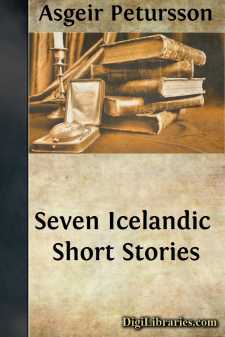Categories
- Antiques & Collectibles 13
- Architecture 36
- Art 48
- Bibles 22
- Biography & Autobiography 813
- Body, Mind & Spirit 142
- Business & Economics 28
- Children's Books 16
- Children's Fiction 13
- Computers 4
- Cooking 94
- Crafts & Hobbies 4
- Drama 346
- Education 46
- Family & Relationships 57
- Fiction 11829
- Games 19
- Gardening 17
- Health & Fitness 34
- History 1377
- House & Home 1
- Humor 147
- Juvenile Fiction 1873
- Juvenile Nonfiction 202
- Language Arts & Disciplines 88
- Law 16
- Literary Collections 686
- Literary Criticism 179
- Mathematics 13
- Medical 41
- Music 40
- Nature 179
- Non-Classifiable 1768
- Performing Arts 7
- Periodicals 1453
- Philosophy 64
- Photography 2
- Poetry 896
- Political Science 203
- Psychology 42
- Reference 154
- Religion 513
- Science 126
- Self-Help 84
- Social Science 81
- Sports & Recreation 34
- Study Aids 3
- Technology & Engineering 59
- Transportation 23
- Travel 463
- True Crime 29
Seven Icelandic Short Stories
by: Asgeir Petursson
Categories:
Description:
Excerpt
Of the seven Icelandic short stories which appear here, the first was probably written early in the thirteenth century, while the rest all date from the early twentieth century. It might therefore be supposed that the earliest of these stories was written in a language more or less unintelligible to modern Icelanders, and that there was a gap of many centuries in the literary production of the nation. This, however, is not the case.
The Norsemen who colonized Iceland in the last quarter of the ninth century brought with than the language then spoken throughout the whole of Scandinavia. This ancestor of the modern Scandinavian tongues has been preserved in Iceland so little changed that every Icelander still understands, without the aid of explanatory commentaries, the oldest preserved prose written in their country 850 years ago. The principal reasons for this were probably limited communications between Iceland and other countries, frequent migrations inside the island, and, not least important, a long and uninterrupted literary tradition. As a consequence, Icelandic has not developed any dialects in the ordinary sense.
It is to their language and literature, as well as to the island separateness of their country, that the 175 thousand inhabitants of this North-Atlantic state of a little more than a hundred thousand square kilometres owe their existence as an independent and separate nation.
The Icelanders established a democratic legislative assembly, the Althingi (Alþingi) in 930 A.D., and in the year 1000 embraced Christianity. Hence there soon arose the necessity of writing down the law and translations of sacred works. Such matter, along with historical knowledge, may well have constituted the earliest writings in Icelandic, probably dating as far back as the eleventh century, while the oldest preserved texts were composed early in the twelfth century. This was the beginning of the so-called saga- writing. The important thing was that most of what was written down was in the vernacular, Latin being used but sparingly. Thus a literary style was evolved which soon reached a high standard. This style, so forceful in its perspicuity, was effectively simple, yet rich in the variety of its classical structure.
There were different categories of sagas. Among the most important were the sagas of the Norwegian kings and the family sagas. The latter tell us about the first generations of native Icelanders. They are all anonymous and the majority of them were written in the thirteenth century. Most of them contain a more or less historical core. Above all, however, they are fine literature, at times realistic, whose excellence is clearly seen in their descriptions of events and character, their dialogue and structure. Most of them are in fact in the nature of historical novels. The Viking view of life pervading them is characteristically heroic, but with frequent traces of the influence of Christian writing.
Besides these there were short stories (þaettir) about Icelanders, of which THE STORY OF AUDUNN AND THE BEAR (Auðunar þáttr vestfirzka) is one of the best known. [Footnote: In this edition, the specially- Icelandic consonants þ and ð are printed as th and d respectively, and the superstressed vowels á,Ã,ó, and ú, are given without the acute accent, when they occur in proper names in the stories, e. g. Pórður: Thordur.]
These may be regarded as a preliminary stage in the development of the longer family saga, simpler, yet having essentially the same characteristics....


